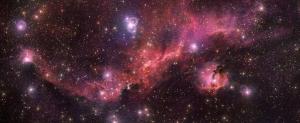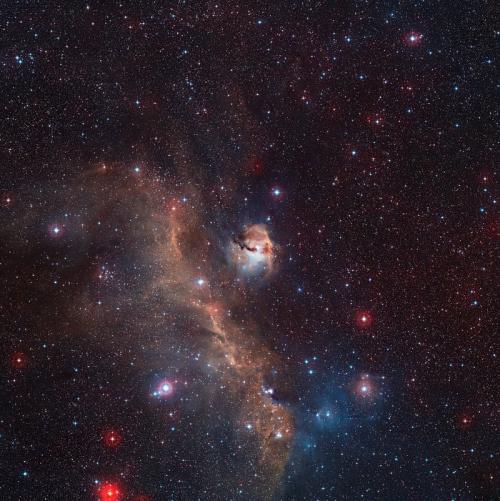Anatomy of a Cosmic Seagull
ESO’s VST captures a celestial gull in flight
Colourful and wispy, this intriguing collection of objects is known as the Seagull Nebula, named for its resemblance to a gull in flight. Made up of dust, hydrogen, helium and traces of heavier elements, this region is the hot and energetic birthplace of new stars. The remarkable detail captured here by ESO’s VLT Survey Telescope (VST) reveals the individual astronomical objects that make up the celestial bird, as well as the finer features within them. The VST is one of the largest survey telescopes in the world observing the sky in visible light.

The Rosy Glow of a Cosmic Seagull.
The main components of the Seagull are three large clouds of gas, the most distinctive being Sharpless 2-296, which forms the “wings”. Spanning about 100 light-years from one wingtip to the other, Sh2-296 displays glowing material and dark dust lanes weaving amid bright stars. It is a beautiful example of an emission nebula, in this case an HII region, indicating active formation of new stars, which can be seen peppering this image.
It is the radiation emanating from these young stars that gives the clouds their fantastical colours and makes them so eye-catching, by ionising the surrounding gas and causing it to glow. This radiation is also the main factor that determines the clouds’ shapes, by exerting pressure on the surrounding material and sculpting it into the whimsical morphologies we see. Since each nebula has a unique distribution of stars and may, like this one, be a composite of multiple clouds, they come in a variety of shapes, firing astronomers’ imaginations and evoking comparisons to animals or familiar objects.

Wide-field view of the entire Seagull Nebula (IC 2177).
This diversity of shapes is exemplified by the contrast between Sh2-296 and Sh2-292. The latter, seen here just below the “wings”, is a more compact cloud that forms the seagull’s “head”. Its most prominent feature is a huge, extremely luminous star called HD 53367 that is 20 times more massive than the Sun, and which we see as the seagull’s piercing “eye”. Sh2-292 is both an emission nebula and a reflection nebula; much of its light is emitted by ionised gas surrounding its nascent stars, but a significant amount is also reflected from stars outside it.
The dark swathes that interrupt the clouds’ homogeneity and give them texture are dust lanes – paths of much denser material that hide some of the luminous gas behind them. Nebulae like this one have densities of a few hundred atoms per cubic centimetre, much less than the best artificial vacuums on Earth. Nonetheless, nebulae are still much denser than the gas outside them, which has an average density of about 1 atom per cubic centimetre.
The Seagull lies along the border between the constellations of Canis Major (The Great Dog) and Monoceros (The Unicorn), at a distance of about 3700 light-years in one arm of the Milky Way. Spiral galaxies can contain thousands of these clouds, almost all of which are concentrated along their whirling arms.
Several smaller clouds are also counted as part of the Seagull Nebula, including Sh2-297, which is a small, knotty addition to the tip of the gull’s upper “wing”, Sh2-292 and Sh2-295. These objects are all included in the Sharpless Catalogue, a list of over 300 clouds of glowing gas compiled by American astronomer Stewart Sharpless.
This image was taken using the VLT Survey Telescope (VST), one of the largest survey telescopes in the world observing the sky in visible light. The VST is designed to photograph large areas of the sky quickly and deeply.
Can you spot the seagull in this photo? We challenge our readers to let their imagination run free and outline the bird in our photo as they see it. Share your photos with the outline of the bird using the hashtag #SpotTheSeagull.
Source: European Southern Observatory
- 224 reads
Human Rights
Ringing FOWPAL’s Peace Bell for the World:Nobel Peace Prize Laureates’ Visions and Actions

Protecting the World’s Cultural Diversity for a Sustainable Future

The Peace Bell Resonates at the 27th Eurasian Economic Summit

Declaration of World Day of the Power of Hope Endorsed by People in 158 Nations

Puppet Show I International Friendship Day 2020

